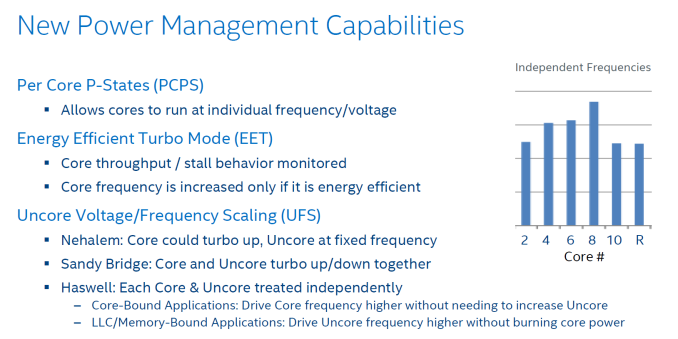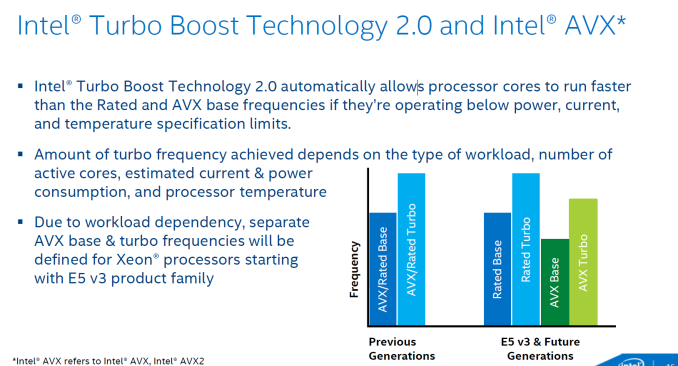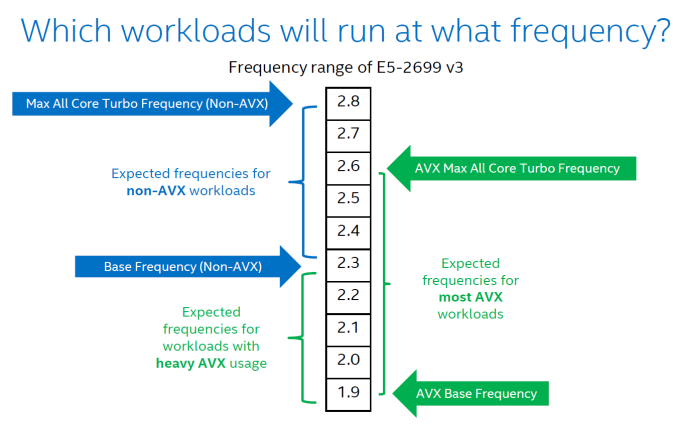Intel Xeon E5 Version 3: Up to 18 Haswell EP Cores
by Johan De Gelas on September 8, 2014 12:30 PM ESTPower Optimizations
It is well known that the Haswell has been optimized for low idle power. Servers run at idle a lot less than mobile devices and thus more power management capabilities were needed.
In Haswell EP, Intel introduces per core p-states (PCPS). PCPS is not necessarily a blessing, as a wrongly chosen p-state can result in higher response times. However, Intel is convinced PCPS will save power or will at least shift the power to where it is needed: to other cores or to the uncore (rings).
Floating Point intensive code is known to cause power peaks. AVX has doubled the theoretical FLOPS, and the FMA (Fused Multiply Add) of AVX 2.0 promises to double it again.
To cope with the huge difference between the power consumption of Integer and AVX code, Intel is introducing new base and Turbo Boost frequencies for all their SKUs; these are called AVX base/Turbo. For example, the E5-2693 v3 will start from a base frequency of 2.3GHz and turbo up to 3.3GHz when running non-AVX code. When it encounters AVX code however, it will not able to boost its clock to more than 3GHz during a 1 ms window of time. If the CPU comes close to thermal and TDP limits, clock speed will drop down to 1.9GHz, the "AVX base clock".
Here, Intel illustrates how this will work for their top SKU, the Xeon E5-2699 v3. Notice the lower base clock for AVX code (1.9 vs 2.3).













85 Comments
View All Comments
bsd228 - Friday, September 12, 2014 - link
Now go price memory for M class Sun servers...even small upgrades are 5 figures and going 4 years back, a mid sized M4000 type server was going to cost you around 100k with moderate amounts of memory.And take up a large portion of the rack. Whereas you can stick two of these 18 core guys in a 1U server and have 10 of them (180 cores) for around the same sort of money.
Big iron still has its place, but the economics will always be lousy.
platinumjsi - Tuesday, September 9, 2014 - link
ASRock are selling boards with DDR3 support, any idea how that works?http://www.asrockrack.com/general/productdetail.as...
TiGr1982 - Tuesday, September 9, 2014 - link
Well... ASRock is generally famous "marrying" different gen hardware.But here, since this is about DDR RAM, governed by the CPU itself (because memory controller is inside the CPU), then my only guess is Xeon E5 v3 may have dual-mode memory controller (supporting either DDR4 or DDR3), similarly as Phenom II had back in 2009-2011, which supported either DDR2 or DDR3, depending on where you plugged it in.
If so, then probably just the performance of E5 v3 with DDR3 may be somewhat inferior in comparison with DDR4.
alpha754293 - Tuesday, September 9, 2014 - link
No LS-DYNA runs? And yes, for HPC applications, you actually CAN have too many cores (because you can't keep the working cores pegged with work/something to do, so you end up with a lot of data migration between cores, which is bad, since moving data means that you're not doing any useful work ON the data).And how you decompose the domain (for both LS-DYNA and CFD makes a HUGE difference on total runtime performance).
JohanAnandtech - Tuesday, September 9, 2014 - link
No, I hope to get that one done in the more Windows/ESXi oriented review.Klimax - Tuesday, September 9, 2014 - link
Nice review. Next stop: Windows Server. (And MS-SQL..)JohanAnandtech - Tuesday, September 9, 2014 - link
Agreed. PCIe Flash and SQL server look like a nice combination to test this new Xeons.TiGr1982 - Tuesday, September 9, 2014 - link
Xeon 5500 series (Nehalem-EP): up to 4 cores (45 nm)Xeon 5600 series (Westmere-EP): up to 6 cores (32 nm)
Xeon E5 v1 (Sandy Bridge-EP): up to 8 cores (32 nm)
Xeon E5 v2 (Ivy Bridge-EP): up to 12 cores (22 nm)
Xeon E5 v3 (Haswell-EP): up to 18 cores (22 nm)
So, in this progression, core count increases by 50% (1.5 times) almost each generation.
So, what's gonna be next:
Xeon E5 v4 (Broadwell-EP): up to 27 cores (14 nm) ?
Maybe four rows with 5 cores and one row with 7 cores (4 x 5 + 7 = 27) ?
wallysb01 - Wednesday, September 10, 2014 - link
My money is on 24 cores.SuperVeloce - Tuesday, September 9, 2014 - link
What's the story with 2637v3? Only 4 cores and the same freqency and $1k price as 6core 2637v2? By far the most pointless cpu on the list.